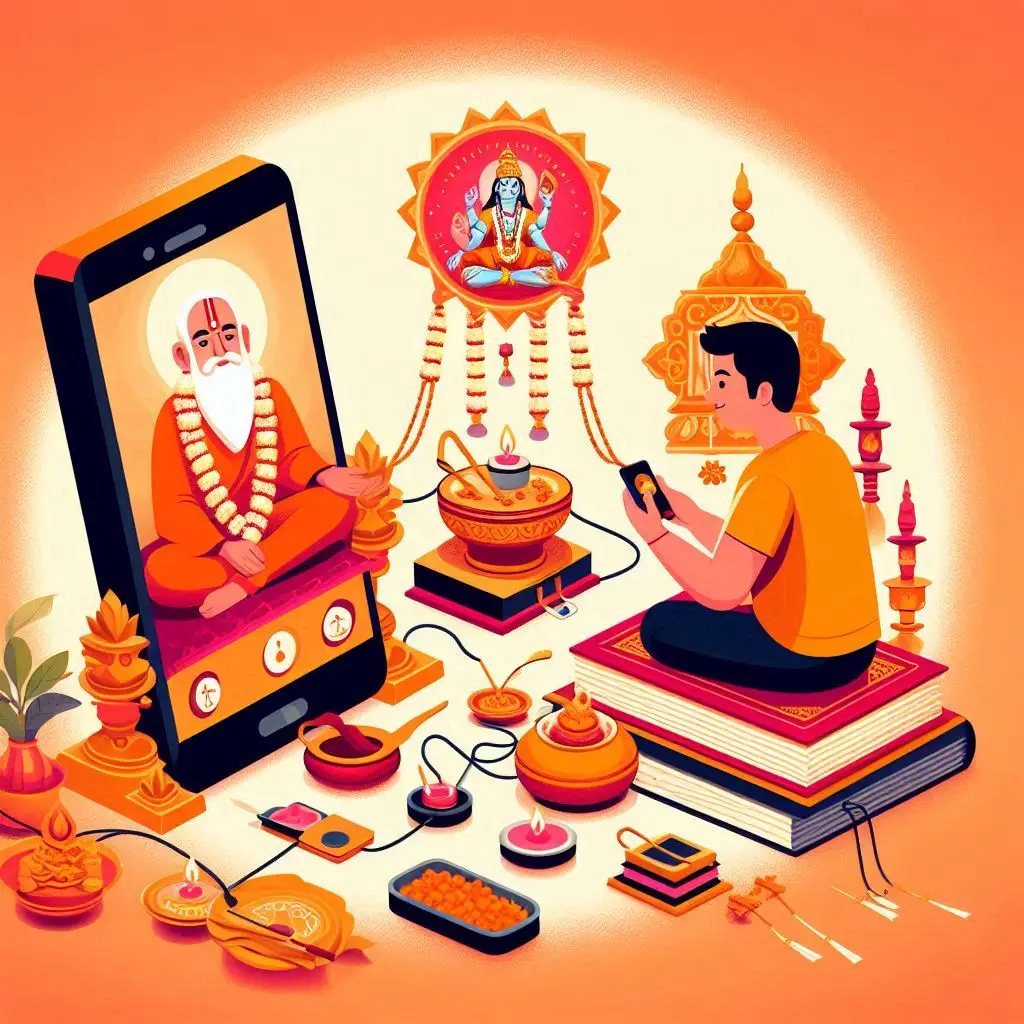The Open-Source Miracle: Developing best Virtual Pooja Platform in 90-Days

Introduction
MadgicalTechdom offers an AI-powered platform for customer engagement and support. We use advanced AI, mobile, web, and Android technology to improve customer interactions and support services. In this blog, we are going to propose our Virtual Pooja Platform made by our team in very little time.
In today’s fast-paced world, more people are seeking spiritual awareness, but finding a traditional pooja with a skilled priest, the right mantras, and a peaceful temple atmosphere is quite rare. Instead of finding inner peace, you often end up crowded with people, dodging elbows and selfie sticks! For those living far away, planning a visit can feel like a secret mission. Even making a donation can be more complicated than it should be. Therefore, we created this Virtual Pooja Platform—because spirituality shouldn’t be a race, and finding peace shouldn’t come with chaos.
After seeing this need, we started building a platform that combines tradition with technology in response to our client, ConveGenius. With over 150 million learners, ConveGenius has a big impact on education. Through their collaboration, we launched the SarvDevasthanam project.
Also, we built the app using modern tools like Expo, NestJS, and open source scheduling infrastructure: Cal.com. In this blog, we’ll briefly discuss the client’s needs, the solution we delivered, and how we completed the project in just 3 months, thanks to open-source tools like Cal.com and AI tools such as Cody and ChatGPT, which saved us up to 18 months of development time. Also, we’ll highlight key features and the app’s impact. Let’s dive in!
Client Requirements for the Virtual Pooja Platform
The client wants to help people connect with famous Indian temples from their homes. Ultimately, they can do poojas and give dakshina (gifts) with the help of special priests who know a lot about prayers. Hence, clients were seeking the following key requirements:
- Virtual Pooja with Priest: The solution should ease devotees to engage in temple rituals remotely. Moreover, if they want to share live videos and recordings, people can watch real-time poojas. This helps devotees and priests connect easily.
- Virtual Pooja Platform: Also, devotees should be able to book various Pooja events from available time slots at their convenience.
- Pooja Event Schedules Management: The solution should enable temple administration to create and manage Pooja schedules that devotees can book.
- Payments Management: The solution should facilitate receiving online payments from devotees for bookings and donations.
- Bookings Management: The temple administration should be able to view bookings and conduct rituals appropriately as per defined schedules.
Our solution for the Virtual Pooja Platform

While the key requirements gave us a solid foundation, there was still significant planning needed. We had to turn these ideas into a smart solution that could grow, stay safe, not cost too much, and be easy for people to use.
Also, we had some challenges, like a small budget, little time, and different needs. Our goal was to make a great solution with a small team, working quickly and well together.
We planned how to build it as per the client’s needs. We decided to make two mobile apps—one for priests and one for devotees—plus a system to manage everything in the background:
- First, we chose Expo as our cross-platform framework, as it allowed us to build for Android, iOS, and Web using a shared codebase. This choice, in turn, enabled faster development and easier maintenance.
- Next, to help schedule poojas and handle bookings, we chose a free tool. We checked out different tools and chose Cal.com because it had what the client needed, and our team knew how to use it well.
- Furthermore, for virtual streaming, we decided not to build from scratch. Instead, we chose Zoom for virtual meetings between priests and devotees. Choosing this tool saved us a lot of work, lowered costs, and made maintenance easier.
Finally, we used an Agile workflow to execute the project. We created 60 user stories, with an estimate of 150 person-days. Through weekly standups with the client and stakeholders, we delivered most of the planned user stories. Only a few low-priority items were left out. In just 3 months, and with only 3-4 team members, we built two mobile apps, an API backend, customized an open-source scheduling system, deployed to AWS, and completed the Play Store setup.
Key Features of the Devotee Virtual Pooja Platform
When we set out to develop the Sarvdevsthanam app, our goal was to create a platform that would provide devotees from anywhere in the world with a rich spiritual experience. Here’s the key feature we implemented:

1. Virtual Pooja Platform
First, we introduced a simple and convenient way for devotees to book various types of online pooja. This feature allows users to choose and schedule poojas at their favorite temples, ensuring that their spiritual practices continue seamlessly, no matter their location.
2. Pratyaksh and Paroksha Poojas
Next, we focused on offering two types of poojas:
- Pratyaksh Pooja: This feature lets users participate in live poojas as they happen. Also, devotees can watch and join the rituals from their homes, maintaining a connection to temple activities.
- Paroksha Pooja: For those who can’t attend live sessions, we added an option to book poojas performed on their behalf, and the recording is available for them to watch later. Moreover, this allows devotees to fulfill their spiritual duties even when they can’t be present.
3. Making Donations and Downloading Invoices
We integrated a secure payment system within the app to make donations easier. People can give money to temples and poojas and get their receipts right after donating. Additionally, it helps them keep track of their gifts for themselves or for tax reasons.
4. Exploring Temples
We also wanted to help users discover new spiritual experiences. However, the app lets users explore a wide range of temples across the country. Each temple offers unique poojas and rituals that users can join online, enhancing their spiritual journey.
5. Browsing Poojas
Alongside exploring temples, users can also browse a variety of poojas available on the Virtual Pooja Platform. Moreover, this feature allows devotees to select rituals that match their spiritual needs, making their experience more personal and fulfilling.
6. Viewing Upcoming and Previous Bookings
To keep things organized, In addition, we also included a feature that tracks all online pooja bookings. Users can see their upcoming events and review past poojas, helping them stay on top of their spiritual activities.
7. Downloading Recordings
After participating in a Pratyaksh Pooja, users can download the recording of the ritual. This lets them revisit the experience anytime or share it with loved ones, fostering a sense of shared spirituality.
Challenges we encountered in creating the Virtual Pooja Platform

The SarvDevasthanam project faced several key challenges in building a platform for devotees, priests, and temple administrators—all within a tight budget.
1. Challenges with Open Source Platform: Cal.com
While Cal.com helped us implement booking features like scheduling poojas and managing temple activities, it wasn’t without its hurdles:
Licensing Issues:
We picked Cal.com for the temple admin part because it was flexible and free to use. But its special rules made it hard for us to change it just the way the client wanted. However, we also missed some important rules about using it at first, which caused us extra costs and affected our budget.
Customization Complexities:
Changing Cal.com’s code took a lot of time and work. The team spent many hours just trying to understand how it worked before they could make changes. Sometimes, changing Cal.com felt hard, like wrestling a big bear, and new requests from the client felt scarier than making a whole new system.
Integration Limitations:
Combining Cal.com with other open-source solutions proved challenging. Compatibility issues made integrating certain features feel like trying to fit square pegs into round holes, limiting the functionality we could ultimately deliver to users.
Payment Integration (Razorpay):
We had trouble using Razorpay because Cal.com doesn’t support it right away. Since we needed payments in Indian rupees (INR), we had to build our own solution to make Razorpay work with Cal.com, which made things even harder.
2. Technical Challenges with Virtual Pooja Platform Development
For cross-platform development, we chose Expo, which uses React Native to build iOS, Android, and web apps with a single codebase. While Expo simplified development, it came with its own set of quirks:
Expo Framework Challenges:
Expo can work on many types of devices, which is great, but making the app used a lot of memory and took up a lot of space. The app builds were so big that they made our system slow, like walking through thick mud, which made it hard to keep working and take care of everything.
Zoom Integration:
To enable virtual calls between priests and devotees, we integrated Zoom. However, Zoom’s official support is limited to native Android and iOS—not React Native or Expo. This meant we had to create a custom workaround with native modules, which felt like trying to make a square dance partner out of a disco ball—definitely not the easiest task!
Even though these challenges made things tougher, they also helped us be creative and flexible. In the end, we built a platform that helps people connect with their spiritual practices, so it was worth the extra effort!
Software Quality Management and Productivity in Virtual Pooja Platform
To ensure that the software quality is high all the time, we’ve adopted several tools and practices that not only kept the artifact quality high but also reduced significant effort during software development.
Optimizing Expo Framework for Enhanced Project Performance
To make the Expo better for our project, we updated our systems and changed some settings to help it work faster and better together. We got the newest version of the Expo and made sure everything was up to date. By using tools like Expo CLI, we also made fewer mistakes, fixed problems, and made the whole development process easier.
- Incremental Builds: We adopted incremental builds to reduce resource consumption. This way, we could only put together the changes we made since the last build. This helped us finish faster and use less memory on the system.
- Modular Architecture: We changed our application into smaller, separate pieces. This made it easier to build and test each part on its own, which helped us use less memory when we made the app.
- Zoom Integration: Adding Zoom to our Expo app was really hard because Zoom didn’t support it directly. This meant we couldn’t use Zoom’s tools the usual way. To fix this, we created our own special tool just for Zoom. It took a lot of research, work, and testing to make sure it worked smoothly in our Expo app.
Improving Code Quality and Efficiency with Development Tools
We used tools like Cody and Sonarlint in VS Code to help us complete code, fix mistakes, and make it better. We also used ChatGPT, Gemini, and other models to help write code. This made our work 40-50% faster.
We added SonarQube to our development process to check the code for problems like bugs, security issues, and areas that can be improved. This helps us keep the code strong by finding problems early on. SonarQube gives us a clear look at the code, showing us parts that might slow things down or cause security risks. By paying attention to these details, we can fix issues quickly and keep our code in good shape, following the best ways to do things.
Boosting Efficiency with CI/CD
We used CI/CD to automate testing and deployment, which kept our workflow smooth and minimized bugs. This approach sped up feature releases and ensured consistent quality across environments. With instant feedback, we could quickly spot and fix issues, streamlining development. We used GitHub Actions and Docker to help our process, which made it faster and easier for the team to work together. This made SarvDevasthanam more reliable and easier to take care of.
Advantages and Highlights of the Virtual Pooja Platform

The SarvDevasthanam app helps people all over the world by making it easy to connect with temples and enjoy their spiritual journey. Here’s a closer look at the advantages and unique highlights of the app:
- Virtual Pooja Platform: The app lets people join poojas online from home, so they don’t have to go to the temple.
- Convenience for Global Users: Sarvdevsthanam serves users worldwide. Those far from their favorite temples can stay connected and participate in rituals from anywhere.
- Time Efficiency: Moreover, with the Virtual Pooja Platform, donations, and temple event access, users save time by avoiding travel and queues.
- User-Friendly Interface: The app has a simple, user-friendly design, making it accessible to all age groups and tech skill levels.
- On-Demand Access: If someone misses a live pooja or wants to see it again, the app lets them download the pooja videos.
- Flexible Donations: The app simplifies the process of making donations, allowing users to contribute according to their preferences and needs.
Success Story: Accelerating Development with Innovative Solutions
We set out to develop two Android apps and a web app, initially estimating it would take about 18 months. Surprisingly, we completed it in just 3 months by adopting a smart, resource-efficient approach.
Instead of starting all over, we carefully changed some free tools. This saved us a lot of time and helped us quickly add things like the booking calendar and the slot booking system for poojas.
We also streamlined the creation of the web admin interface, further speeding up the process. By working smarter, we not only met but exceeded expectations, delivering a fully functional suite of apps in record time.
This project showcased our ability to innovate and adapt, proving that with the right strategy, we can achieve remarkable results far ahead of schedule.
Conclusion
SarvDevasthanam mixes old traditions with new technology to change how people connect with their faith. It lets users join poojas, give donations, and explore temples online from anywhere.
SarvDevasthanam has features like live videos, recorded poojas, and easy ways to give donations. This helps people connect with their faith. The app is simple to use and safe, with things like email checks and secure payments to make sure everyone has a good experience.
SarvDevasthanam uses new ideas to keep important traditions alive and make them easy for people all over the world to enjoy. This helps bring spiritual happiness into today’s digital world.
End Note
Thank you 🙌🏻 for joining us on this journey through our blog! We hope you find it informative and insightful ✨. Remember, the journey doesn’t end here. If you have any questions or feedback 💬, need further assistance, or want us to do the same work for you, don’t hesitate to reach out to us
Further Readings
- 30% Time Savings in AI Development: The EKS CI/CD Solution
- How to Achieve 60% AWS Cost Optimization with Functions and Tags
- How to Optimize QA Automation for 30% Quicker Releases
- Top Challenges In The Migration To A Microservices Platform
- How to Automate AI Chatbot Testing Using Our Best Solution?
Follow Us
Disclaimer
The views are those of the author and are not necessarily endorsed by Madgical Techdom.